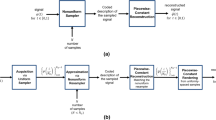Abstract
Digital sampling of cardiac electrograms and electrocardiograms is usually performed by sampling at uniform intervals with rates high enough to record the fastest signal components. Numerous redundant samples are recorded during slower deflections and baseline intervals, particularly for direct cardiac measurements that include fast Purkinje deflections. In this report, five adaptive sampling methods (voltage triggered, two-point projection, second differences, the fan and CORTES) are compared with uniform sampling for cardiac waveforms. For the electrogram, the results indicated that adaptive sampling based on the fan method might be used effectively to limit average data rates to moderate values during original data acquisition
Similar content being viewed by others
References
Abenstein, J. P. (1978) Algorithms for real-time ambulatory ECG monitoring.Biomed. Sci. Instrum.,14, 73–77.
Abenstein, J. P. andTompkins, W. J. (1982) A new data-reduction algorithm for real-time ECG analysis.IEEE Trans. BME-29, 43–48.
Andrews, C. A., Davies, J. M. andSchwarz, G. R. (1967) Adaptive data compression.Proc. IEEE,55, 267–277.
Barr, R. C. andSpach, M. S. (1977) Sampling rates required for digital recording of intracellular and extracellular cardiac potentials.Circulation,55, 40–48.
Berson, A. S., Wojick, J. M. andPipberger, H. V. (1977) Precision requirements for electrocardiographic measurements computed automatically.IEEE Trans.,BME-24, 382–385.
Blanchard, S. M., Barr, R. C. andSpach, M. S. (1982) A voltagetriggered system for adaptive sampling in body surface mapping.,BME-29, 726–730.
Blanchard, S. M. andBarr, R. C. (1982) Zero, first, and second order adaptive sampling of ECGs.Proc. 35th ACEMB, Philadelphia, PA.
Borjesson, P. O., Einarsson, G. andPahlm, O. (1980) Comments on ‘Compression of the ECG by prediction or interpolation and entropy encoding’.IEEE Trans. BME-27, 674–675.
Cox, J. R., Nolle, F. M., Fozzard, H. A. andOliver, G. C. (1968) AZTEC, a preprocessing program for real-time ECG rhythm analysis.,BME-15, 128–129.
Cox, J. R., Fozzard, H. A., Nolle, F. M. andOliver, G. C. (1974) Some data transformations useful in electrocardiography. InComputers and biomedical research.Stacy, R. W. andWaxman, B. D., (Eds.), Chap. 3, 182–206.
Dower, G. E. (1974) Progress in electrocardiology, Part 2: data display, compression and transmission.J. Biomed. Eng.,9, 296–297.
Evans, A. K. andLux, R. L. (1978) Reduction of temporal redundancy in ECG body surface maps.Proc. 31st ACEMB,31, 168.
Gardenhire, L. W. (1964) Redundancy reduction, the key to adaptive telemetry. Proceedings of the 1964 National Telemetering Conference, Los Angeles, CA, Section 1–5, pp. 1–16.
Gardenhire, L. W. (1965) Data redundancy reduction for biomedical telemetry. InBiomedical telemetry.Caceres, C. A. (Ed.), Academic Press, New York, Chap. 11, 255–298.
Ishijima, M., Shin, S.-B., Hostetter, G. andSklansky, J. (1983) Scan-along polygonal approximation for data compression of electrocardiograms.IEEE Trans.,BME-30, 723–729.
Kinias, P. andFozzard, H. A. (1979) Rapid ECG analysis and arrhythmia detection. InComputer techniques in cardiology.Cady, L. D. Jr. (Ed.), Biomed. Eng. & Instrumentation Series, Vol. 4, Marcel Dekker, New York, 97–122.
Kortman, C. M. (1967) Redundancy reduction—a practical method of data compression.Proc. IEEE,55, 253–263.
Langner, P. H. Jr., Geselowitz, D. B. andBriller, S. A. (1973) Wide band recording of the electrocardiogram and coronary heart disease.Am. Heart. J.,86, 308–317.
Marvell, C. J. andKirk, D. L. (1980a) Use of a microprocessor to simulate precise electrocardiograms.J. Biomed. Eng.,2, 61–62.
Marvell, C. J. andKirk, D. L. (1980b) A simple software routine for the reproducible processing of the electrocardiogram.,2, 216–220.
Mueller, W. C. (1978) Arrhythmia detection program for an ambulatory ECG monitor.Biomed. Sci. Instrum.,14, 81–85.
Pahlm, O., Borjesson, P. D. andWerner, O. (1979) Compact digital storage of ECGs.Comput. Programs in Biomedicine,9, 293–300.
Ruttimann, U. E., Berson, A. E. andPipberger, H. V. (1976) ECG data compression by linear prediction.Computers in Cardiology, IEEE Computer Society, 313–315.
Ruttimann, U. E. andPipberger, H. V. (1979) Compression of the ECG by prediction or interpolation and entropy encoding.IEEE Trans.,BME-26, 613–623.
Shakin, V. V., Breuer, P., Szekely, E., Kobzos, L., Wolf, T. andNemeth, J. (1977) Adaptive compression and filtering for vectorial electrocardiogams.Adv. Card.,19, 169–170.
Shakin, V. V., Csapodi, C., Preda, I., Kenedi, P. andBreuer, P. (1978) Adaptive data reduction in body surface mapping.,21, 40–43.
Shridhar, M. andStevens, M. F. (1979) An analysis of ECG data, for data compression.Int. J. Bio-Med. Comput.,10, 113–128.
Spach, M. S., Barr, R. C., Johnson, E. A. andKootsey, J. M. (1973) Cardiac extracellular potentials. Analysis of complex wave forms about the Purkinje network in dogs.Circ. Res.,33, 465–473.
Stewart, D., Dower, G. E. andSuranyi, O. (1973) An ECG compression code.J. Electrocardiology,6, 175–176.
Tompkins, W. J. (1978) A portable microcomputer based system for biomedical applications.Biomed. Sci. Instrum.,14, 61–66.
Tompkins, W. J. andAbenstein, J. P. (1979) CORTES—a data reduction algorithm for electrocardiography.Proc. 14th AAMI, Las Vegas, Nevada, 277.
Tompkins, W. J. andWebster, J. G. (Eds.) (1981)Design of microcomputer-based medical instrumentation. Prentice-Hall, Englewood Cliffs, New Jersey, 433–461.
Webster, J. G. (1978) An intelligent monitor for ambulatory ECGs.Biomed. Sci. Instrum.,14, 55–60.
Wolf, H. K., Sherwood, J. D. andKanon, D. J. (1976) The effect of signal noise on the performance of several ECG programs. InComputers in Cardiology, IEEE Computer Society, 303–305.
Womble, M. E., Halliday, J. S., Mitter, S. K., Lancaster, M. C. andTriebwasser, J. H. (1977) Data compression for storing and transmitting ECGs/VCGs.Proc. IEEE,65, 702–706.
Author information
Authors and Affiliations
Rights and permissions
About this article
Cite this article
Blanchard, S.M., Barr, R.C. Comparison of methods for adaptive sampling of cardiac electrograms and electrocardiograms. Med. Biol. Eng. Comput. 23, 377–386 (1985). https://doi.org/10.1007/BF02441592
Received:
Accepted:
Issue Date:
DOI: https://doi.org/10.1007/BF02441592




